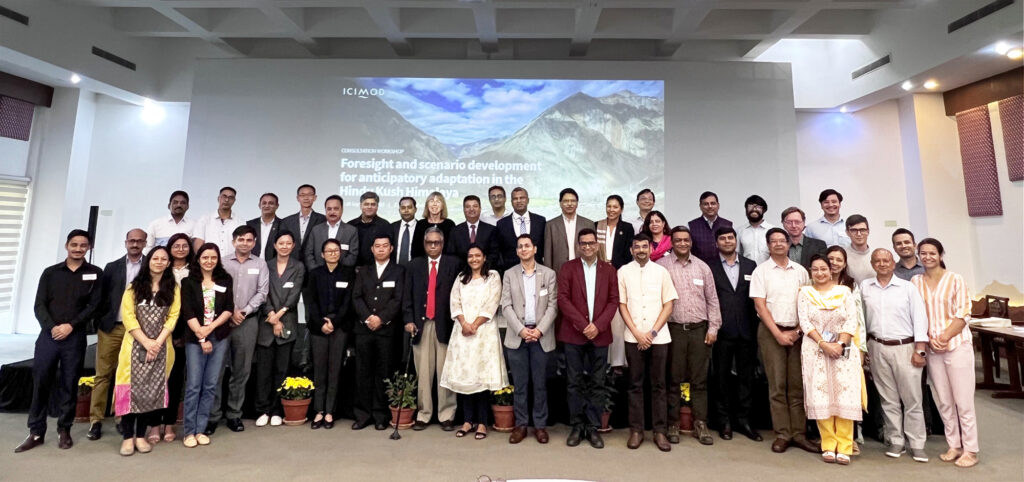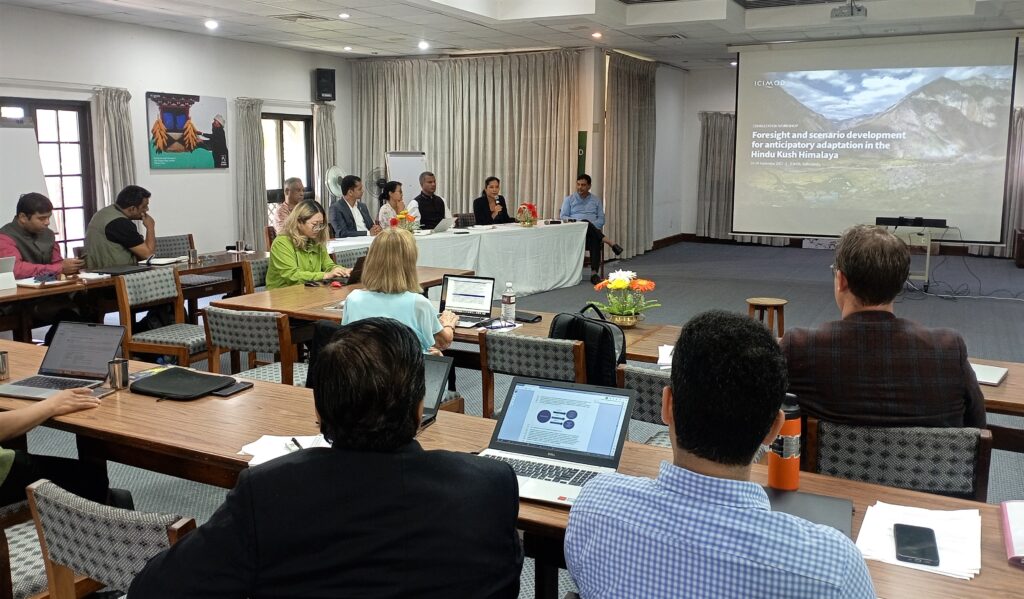By Amina Maharjan
Achieving the Sustainable Development Goals by 2030 is becoming ever more challenging in the Hindu Kush Himalaya (HKH), as the region grapples with the many complex and interconnected crises of climate change, biodiversity loss, food and water insecurity, and growing economic inequality, among others. We do not need a crystal ball to help us see what the future climate could hold in store for the people and environment of this region. It is already experiencing the devastating impacts of climate change, with new temperature and precipitation records continually being surpassed. More severe and frequent extreme weather events, such as droughts, floods, and avalanches are becoming the norm. For the HKH, elevation-dependent heating means that even a temperature increase of 1.5°C is too hot for the sustainable wellbeing of the region’s people and ecosystems.
If ‘business as usual’ and current emission trends continue, the HKH is on course to experience irreversible changes in its natural and social systems. Without enough food, water, or energy, life would be challenging for the millions of people who call the HKH home, and for some, it would simply be unliveable. It is vital that we start thinking about what kind of future we want to create and how we can act when the worst-case scenario thresholds are crossed. We need to plan for an uncertain future and be better prepared for these worst-case scenarios.
In order to brainstorm together on these shared uncertainties, over 40 participants representing 25 organizations from six countries in the region – Bangladesh, Bhutan, China, India, Nepal, and Pakistan – and beyond – Austria, Thailand, United Kingdom, United States of America – came together for a consultative workshop on ‘Foresight and Scenario Development for Anticipatory Adaptation in the Hindu Kush Himalaya’ on 19–20 September 2023, organized by the International Centre for Integrated Mountain Development (ICIMOD) in Kathmandu, Nepal. The participants included representatives from governments, international organizations, NGOs, think tanks, universities, and research institutions.

Over the two days, the participants engaged in a horizontal scanning exercise to look at potential changes/disruptors in the HKH region in the future. The group also looked at building capacity for foresight and futures thinking at different scales of planning – from national to local levels.
Foresight and scenarios are tools that can help us reimagine plural futures. They help us think about the future in systematic, rigorous, and inclusive ways. It involves identifying potential future trends and challenges in order to develop strategies to address them. This approach has not been used widely in this region, but that needs to change as we prepare for an uncertain future.

This gathering was the beginning of a process to encourage futures thinking in the region. Overall, there was consensus on the need for futures thinking across sectors and scales and a commitment to continue collaboration. As a participant from Bangladesh highlighted “We cannot only depend on the past (and historic trends) to plan our future under the rapid change and uncertainty that we are witnessing in the region. It is critically important to envision futures at different scales and with diverse stakeholders to drive our actions now.” Without foresight and scenarios thinking, no organisation or community can remain future fit.
Such planning is especially crucial for a region as vulnerable as the HKH – subject not only to the extremities of its geography and topography, but also because of its varied social, demographic, political and economic conditions. Just one major weather event can set communities back 20 years in development. We must think creatively and long-term about how to address the major challenges, and we must do it now.
By Just Dengerink
Foresight training for Africa Foresight Academy by Foresight4Food researchers and Wageningen University & Research (WUR)
The Foresight4Food initiative aims to connect and inspire networks of foresight professionals around the world. In early July 2022, members of the Africa Foresight Academy participated in a foresight training at Oxford, provided by Foresight4Food researchers from the University of Oxford’s Environmental Change Institute (ECI) in collaboration with Wageningen University & Research (WUR). The training was attended by five African researchers in person, while five others joined in online.

The Foresight4Food ‘seven steps’ approach to scenario and foresight analysis (see illustration below) was used to develop four scenarios for a more climate-resilient Ghana in 2040. Here’s a look at how these scenarios were developed using the Foresight4Food approach in the training session.

Scoping the process and mapping the food system
The scenario exercise started with scoping and delineating the focus of the scenario process Collectively, it was decided to focus the scenarios on the future of the Ghana food system in 2040, and the resilience of this system to external shocks related to climate change.
Participants were invited to draw a ‘rich picture’ of the Ghana food system to map out its most important features. These included small-scale yam and cocoa production in the south, maize and sorghum production in the north, fisheries along the coast and around Lake Volta along with the role of urban informal food markets, the lack of a large food processing sector, Covid-19’s impact on supply chains, growing security threats in the region, and the effect of the war in Ukraine on fuel prices and availability of fertilizers.

From assessing trends and uncertainties to constructing scenarios
Building upon the key features of the Ghana food system from the ‘rich picture’ exercise, participants were then invited to identify the most important trends and uncertainties affecting the Ghana food system.
Highlighted key trends included fast population growth and urbanization, increasing use of technology, growing dependence on food imports and remittances, decreasing occurrence of crop diseases, growing youth unemployment, and the increase in fast food consumption.
Together, the participants also identified some important uncertainties regarding the future of the Ghana food system: the degree of extreme weather events, the implementation efficiency of climate resilience policies, and the vulnerability of households to climate change. Other uncertainties identified included future access to fertilizers, fluctuations in fuel prices, changes in trade regimes, levels of agricultural productivity, the expected value of the Ghanaian currency, the potential influence of future Covid outbreaks and the impact of developments in the general security of the region.
The participants then decided on two key uncertainties that would be critical in determining the future climate resilience of the Ghanaian food system. Based on these two key uncertainties, a matrix was created with each of the axes representing one uncertainty. Within this matrix, four scenarios were constructed, based on their position on both axes and with input from the other uncertainties that were identified.

Assessing implications, exploring system changes and designing pathways
With the four scenarios in place, participants were invited to give more colour to these four plausible futures by exploring the implications of each scenario for different stakeholder groups. One group explored the implications for rural farmers, while the other focused on urban consumers.
With the implications of each scenario explored in more detail, participants were asked to zoom out and think about the possible system changes that – in each scenario – could contribute to a more climate-resilient future of the Ghanaian food system. Suggestions included the stimulation of climate-smart agriculture practices, diversification of production and dietary patterns, strengthening regional trade, supporting home gardens and peri-urban agriculture and digitalization of supply chain management.
This three-day exercise with African foresight experts showed how the Foresight4Food approach can help structure a participatory foresight process that leads to engaging scenarios and actionable policy recommendations to shape the future of our food systems.
